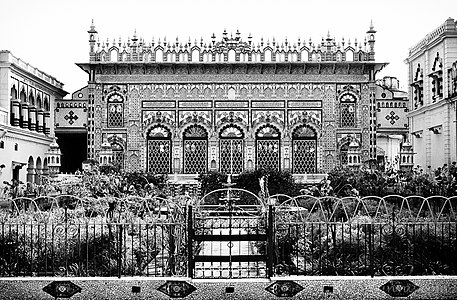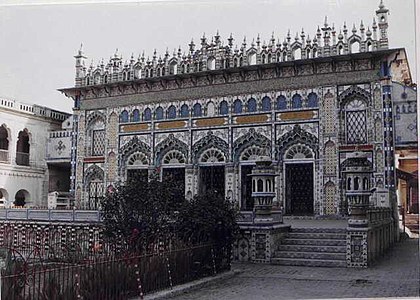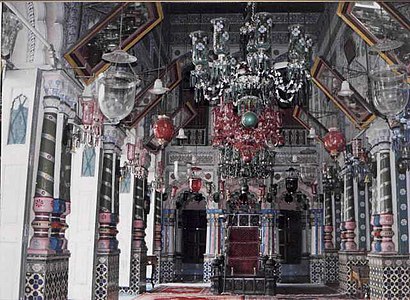Syed Ibne Hasan Nonaharvi
Syed Ibne Hasan Nunahrvi (or Nonaharvi or Nonaharavi or Naunahrvi or Naunaharvi) (نادرة الزمین مولانا سيد ابن حسن نونهروى)(1899-1980), was an Indian Shia Muslim cleric, zakir (orator) and alim (scholar).
Syed Ibne Hasan Nunahrvi alias Maulana Nunahrvi | |
|---|---|
| Title | Naadiratul Zaman |
| Personal | |
| Born | 1899 |
| Died | 1980 |
| Religion | Islam |
| Ethnicity | Indian Sayyid |
| Era | Modern era |
| Jurisprudence | Ja`fari |
| Creed | Usuli Twelver Shi`a Islam |
| Main interest(s) | meraj, Battles of Islam (involving Muhammad & Ali) Nahjul Balagha, Arabic, usool, fiqh |
| Notable idea(s) | New format of Majlis-e-Aza |
| Muslim leader | |
Influenced by
| |
Early life
He was born in 1899 in village Nonahara, Ghazipur in North-Western Provinces, British India.
As student & teacher
Studies
He went to Islamic school in Nonahara, Ghazipur, UP, India and then moved to Lucknow for higher Shia religious education. He graduated from Sultanul Madaris.[1]
Maulana Nonaharvi was a student of Allama Syed Ahmad Raza Saheb, Baqirul Uloom Maulana Syed Mohammad Baqir Saheb, and Nasirul Millat Syed Nasir Husain Moosavi Kintoori, Allama Syed Sibte Hasan Naqvi,[2][1] etc.
In academics
He continued his teaching work at Sultanul Madaris and then became Principal of Madrasatul Waizeen,[1] where he was known for his teachings of Nahjul Balagha, Arabic, usool, fiqh and guided his students to become great reciter.
As orator
Maulana Syed Ibne Hasan Nunahrvi was renowned for his oratory and Urdu language speeches. He was a pious and sincere scholar with tremendous control over religious matters and reciting majlis.[2]
Maulana Nunahrvi learned the art of oratory from his teacher Allama Syed Sibte Hasan Naqvi, who was the pioneer of the format of majalis which are recited to the present day.[2] Before their time, majalis in Lucknow and other places contained marsiya, recited by great poets like Meer Babbar Ali Anees and Mirza Dabeer. The new format had khutba in Arabic, some tafseer with fazail of Ahlul Bayt lastly masaeb of Karbala.[2][1]
Maulana Nunahrvi was known for his beautiful language[2] and delivery of difficult tafseer and Islamic philosophy. He was also considered the best orator of the topic of meraj and the battles of Islam (involving Muhammad & Ali). His description of the battlefield and meraj had such an effect on people that the description was said to take the imagination of the listener into the event itself. He traveled a lot and was able to recite a single majalis for 4 hours, not repeating the same topic twice. His vocabulary, control over Persian, Urdu,[2] and Arabic languages, and usage of exemplary sentences with proper qafia and continuous flow with "Gul o Bulbul", control over his audience[2] and making topics interesting made him extremely popular and known all over the sub-continent. He was an expert orator and recited long majalis with excellent delivery of words, and was also known as an orator who used to ask his audience to recite salawat more than 100 times in a single majlis.[1]
Many of his followers used to travel long distance to listen to his majalis and had great affection for his recitations. Maulana was known for reciting esale sawab majalis due to his choice of Ayat for the deceased person. He chose Surah Nun for easale sawab majlis of the founder of Nizami Press, Lucknow who spent all his life writing and printing books. Maulana recited majlis e tarheem for Nasirul Millat and many prominent people and always ensured fazail and masaib of masoomeen consoles the grieving family.
Allama Nunahrvi started his career at Husainia Irshadia, Rudauli by invitation of Syed Irshad Husain Zaidi(d.1954) and remained a permanent zakir there for 58 years until his death.[2][1] For 58 years, he recited majalis and mahafil in front of leaned audience and never repeated any majlis. Chaudhry Irshad’s son Ali Muhammad Zaidi(1914-2004) authored a books named Ibne Hasan aur Rudauli.[3][4]
 Husainia Irshadia, Rudauli
Husainia Irshadia, Rudauli Husainia Irshadia, Rudauli
Husainia Irshadia, Rudauli Inside Husainia Irshadia, Rudauli
Inside Husainia Irshadia, Rudauli Inside Husainia Irshadia, Rudauli
Inside Husainia Irshadia, Rudauli
Once he asked his host to name the ayat of his choice when he goes on pulpit and recited the majlis in his well known manner. In one majlis he described the incident - Muhammad asked Salman and Abu Zar to go and get Ali as he was suffering from eye infection, late Maulana said the following when both companions were coming back supporting Ali in the middle:
Ek taraf jaushan kabir
Ek taraf jaushan sagheer
Beech me janabe ameer
He also addressed majalis at Hyderabad, Rampur, Jalali, Lucknow and many other places.[2][1]
He gave speech at Bismillah ceremony of eldest sister's son of Rahi Masoom Raza (they called Maulana Nunahrvi as Khalu Miyan) on 3rd Shaban where Qais Zangipuri too was present. [5]
Personal life
He was a pious and sincere scholar,[2] and was a simple person in his personal life and used to walk to madrasa everyday. During the last few years of his life he became ill and cut down on traveling. He died at the age of 81 years on 25 March 1980,[6] in Lucknow and was buried in Imambara Ghufran Ma'ab.[1]
Syed Shabihul Hasan Nonaharvi
His eldest son, Shia cleric Maulana Doctor Professor Allama Syed Shabihul Hasan Nonaharvi, died on May 13, 1998,[6], was professor and chairman of 'Urdu Department' at Lucknow University,[7][8][9] and ex-principal of Madrasatul Waizeen. He was the last recipient of the combined club prize of AMU Student's Union medal in 1945. Like his father was a cleric, scholar and orator and an expert on Arabic, Persian and Urdu.[10]
Syed Shabihul Hasan has authored following books,
- Nasikh: tajziya wa taqdeer[11]
- Hazrat Imam Husain ki Jeewan Kalpana Unke Viswas aur Jihad ke Parkash me[12]
- Kerbala ki Ghatna[13]
- Diwan-i-Sadghazal[14]
- Nasikh Tajziyah wa Taqdir[15]
- Ahsanul Majalis[16]
Dr. Abbas Raza Nayyar, Associate Professor & Head of Department of Urdu, Lucknow University, published following works related to Syed Shabihul Hasan,[17]
References
- "Maulana Syed Ibne Hasan". yaimam.com. 9 May 2012. Retrieved 9 July 2020.
- "Current Format of Majlis-E-Aza". alqaem.org. Retrieved 9 July 2020.
- "Hussainia Irshadia- Beautiful Imambara of Rudauli". Heritage Guru. 15 December 2014. Retrieved 9 July 2020.
- Josbi, Esha Basanti (1964). Uttar Pradesh District Gazetteers: Bara Banki. Allahabad, U. P.: Government of Uttar Pradesh, (Department of Dtstrict Gazetteers, Lucknow). p. 252. Archived from the original on 26 January 2017. Retrieved 9 July 2020.
Waqf Husainia Irshadia— The waqf was founded by Chaudhary Irshad Husain, talukdar of Narauli, for religious and charitable purposes. In 1922 he built a big imambara in the premises of his own house, Irshad Manzil. The waqf was registered on November 5, 1946. The annual income of the waqf is about Rs 11,419. The money is spent on Moharram celebrations and in giving monetary help to pilgrims going to Karbala. A sum of Rs3,000 is given annually in charity to poor persons, widows and orphans.
- Hooker, Roger Hardham (1998). Narrating our nations : Teape lectures 1996-97. Bangalore, India: Published by I.S.P.C.K. for United Theological College, Bangalore. pp. 15, 16. ISBN 8172144350. Retrieved 10 October 2018.
- "Ziaraat". ziyaraat.net. Retrieved 9 July 2020.
- "University of Lucknow". udrc.lkouniv.ac.in. Retrieved 9 July 2020.
- Hasan, Amir (1983). Palace Culture of Lucknow. B.R. Publishing Corporation. Retrieved 9 July 2020.
I wish to express my sincere thanks to Dr. Syed Shabihul Hasan Naunaharvi, an eminent scholar and Professor and Head of the Urdu Department of Lucknow University, who guided me to a large portion of source material used in this book.
- عابدى نامه (in Persian). گروه زبان و ادبيات فارسى ، دانشگاه دهلى،. 1990. Retrieved 9 July 2020.
Prof . S . Shabihul Hasan Deptt . of Urdu , Lucknow University , Lucknow
- "E-Newsletter - Sahitya Akademi" (PDF). Retrieved 9 July 2020.
Sahitya Akademi New Delhi organized a Through My Window programme on 13 October 2015 at Lucknow Campus of Maulana Azad National Urdu University in which Prof. Anis Ashfaq, former Head, Dept. of Urdu, Lucknow University was invited to speak on the life and works of Prof. Shabihul Hasan, renowned Urdu litterateur and critic. Prof. Anis Ashfaq said that Prof. Shabihul Hasan was a multi-dimensional Urdu scholar. He was famous for his work on Nafsiyati Tanqeed (Psychological critics)
Cite journal requires|journal=(help) - "Nasikh: tajziya wa taqdeer". Rekhta. Retrieved 9 July 2020.
- "HAZRAT IMAM HUSAIN KI JEEWAN KALPANA UNKE VISHWAS AUR JIHAD KE PARKASH ME BY DR SHABIHUL HASAN NONAHARVI PUBLISHED BY NHF.PDF" (PDF) (in Hindi). Indian Shia Encyclopedia. Retrieved 9 July 2020.
- "KERBALA KI GHATNA BY MAULANA SHABIUL HASAN NAUNEHRAVI PUBLISHED BY NOORE HIDAYAT FOUNDATION LUCKNOW.PDF" (PDF) (in Hindi). Indian Shia Encyclopedia. Retrieved 9 July 2020.
- "Sources On Awadh From 1722 A.d. To 1856 A.d." Retrieved 9 July 2020.
Diwan-i-Sadghazal of Dr. S. Shabih-ul-Hasan (Luckonw, 1973).
- "Sources On Awadh From 1722 A.d. To 1856 A.d." Retrieved 9 July 2020.
Nasikh Tajziyah wa Taqdir of Dr. Shabihul Hasan Nonehervi (Lucknow, 1974).
- "AHSANUL MAJALIS". tanzeemulmakatib.org. Retrieved 9 July 2020.
- "Literary Works and Academic Achievements of Dr. Abbas Raza Nayyar" (PDF). Retrieved 9 July 2020.